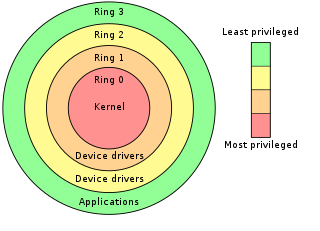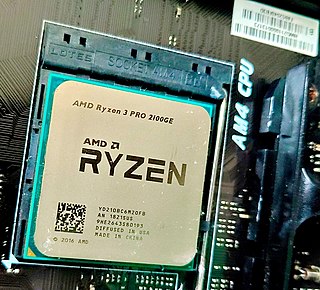Related Research Articles
W^X is a security feature in operating systems and virtual machines. It is a memory protection policy whereby every page in a process's or kernel's address space may be either writable or executable, but not both. Without such protection, a program can write CPU instructions in an area of memory intended for data and then run those instructions. This can be dangerous if the writer of the memory is malicious. W^X is the Unix-like terminology for a strict use of the general concept of executable space protection, controlled via the mprotect system call.
In computer security, executable-space protection marks memory regions as non-executable, such that an attempt to execute machine code in these regions will cause an exception. It makes use of hardware features such as the NX bit, or in some cases software emulation of those features. However, technologies that emulate or supply an NX bit will usually impose a measurable overhead while using a hardware-supplied NX bit imposes no measurable overhead.
The Time Stamp Counter (TSC) is a 64-bit register present on all x86 processors since the Pentium. It counts the number of CPU cycles since its reset. The instruction RDTSC returns the TSC in EDX:EAX. In x86-64 mode, RDTSC also clears the upper 32 bits of RAX and RDX. Its opcode is 0F 31. Pentium competitors such as the Cyrix 6x86 did not always have a TSC and may consider RDTSC an illegal instruction. Cyrix included a Time Stamp Counter in their MII.

The Pwnie Awards recognize both excellence and incompetence in the field of information security. Winners are selected by a committee of security industry professionals from nominations collected from the information security community. Nominees are announced yearly at Summercon, and the awards themselves are presented at the Black Hat Security Conference.
In computer security, virtual machine escape is the process of a program breaking out of the virtual machine on which it is running and interacting with the host operating system. A virtual machine is a "completely isolated guest operating system installation within a normal host operating system". In 2008, a vulnerability in VMware discovered by Core Security Technologies made VM escape possible on VMware Workstation 6.0.2 and 5.5.4. A fully working exploit labeled Cloudburst was developed by Immunity Inc. for Immunity CANVAS. Cloudburst was presented in Black Hat USA 2009.

The Intel Management Engine (ME), also known as the Intel Manageability Engine, is an autonomous subsystem that has been incorporated in virtually all of Intel's processor chipsets since 2008. It is located in the Platform Controller Hub of modern Intel motherboards.
Intel Software Guard Extensions (SGX) is a set of instruction codes implementing trusted execution environment that are built into some Intel central processing units (CPUs). They allow user-level and operating system code to define protected private regions of memory, called enclaves. SGX is designed to be useful for implementing secure remote computation, secure web browsing, and digital rights management (DRM). Other applications include concealment of proprietary algorithms and of encryption keys.

Ryzen is a brand of multi-core x86-64 microprocessors designed and marketed by AMD for desktop, mobile, server, and embedded platforms based on the Zen microarchitecture. It consists of central processing units (CPUs) marketed for mainstream, enthusiast, server, and workstation segments and accelerated processing units (APUs) marketed for mainstream and entry-level segments and embedded systems applications.

Kernel page-table isolation is a Linux kernel feature that mitigates the Meltdown security vulnerability and improves kernel hardening against attempts to bypass kernel address space layout randomization (KASLR). It works by better isolating user space and kernel space memory. KPTI was merged into Linux kernel version 4.15, and backported to Linux kernels 4.14.11, 4.9.75, and 4.4.110. Windows and macOS released similar updates. KPTI does not address the related Spectre vulnerability.

Meltdown is one of the two original transient execution CPU vulnerabilities. Meltdown affects Intel x86 microprocessors, IBM POWER processors, and some ARM-based microprocessors. It allows a rogue process to read all memory, even when it is not authorized to do so.

Spectre refers to one of the two original transient execution CPU vulnerabilities, which involve microarchitectural timing side-channel attacks. These affect modern microprocessors that perform branch prediction and other forms of speculation. On most processors, the speculative execution resulting from a branch misprediction may leave observable side effects that may reveal private data to attackers. For example, if the pattern of memory accesses performed by such speculative execution depends on private data, the resulting state of the data cache constitutes a side channel through which an attacker may be able to extract information about the private data using a timing attack.
Speculative Store Bypass (SSB) is the name given to a hardware security vulnerability and its exploitation that takes advantage of speculative execution in a similar way to the Meltdown and Spectre security vulnerabilities. It affects the ARM, AMD and Intel families of processors. It was discovered by researchers at Microsoft Security Response Center and Google Project Zero (GPZ). After being leaked on 3 May 2018 as part of a group of eight additional Spectre-class flaws provisionally named Spectre-NG, it was first disclosed to the public as "Variant 4" on 21 May 2018, alongside a related speculative execution vulnerability designated "Variant 3a".
Lazy FPU state leak, also referred to as Lazy FP State Restore or LazyFP, is a security vulnerability affecting Intel Core CPUs. The vulnerability is caused by a combination of flaws in the speculative execution technology present within the affected CPUs and how certain operating systems handle context switching on the floating point unit (FPU). By exploiting this vulnerability, a local process can leak the content of the FPU registers that belong to another process. This vulnerability is related to the Spectre and Meltdown vulnerabilities that were publicly disclosed in January 2018.

Foreshadow, known as L1 Terminal Fault (L1TF) by Intel, is a vulnerability that affects modern microprocessors that was first discovered by two independent teams of researchers in January 2018, but was first disclosed to the public on 14 August 2018. The vulnerability is a speculative execution attack on Intel processors that may result in the disclosure of sensitive information stored in personal computers and third-party clouds. There are two versions: the first version (original/Foreshadow) targets data from SGX enclaves; and the second version (next-generation/Foreshadow-NG) targets virtual machines (VMs), hypervisors (VMM), operating systems (OS) kernel memory, and System Management Mode (SMM) memory. A listing of affected Intel hardware has been posted.
In digital computing, hardware security bugs are hardware bugs or flaws that create vulnerabilities affecting computer central processing units (CPUs), or other devices which incorporate programmable processors or logic and have direct memory access, which allow data to be read by a rogue process when such reading is not authorized. Such vulnerabilities are considered "catastrophic" by security analysts.
Spoiler is a security vulnerability on modern computer central processing units that use speculative execution. It exploits side-effects of speculative execution to improve the efficiency of Rowhammer and other related memory and cache attacks. According to reports, all modern Intel Core CPUs are vulnerable to the attack as of 2019. AMD has stated that its processors are not vulnerable.

The Microarchitectural Data Sampling (MDS) vulnerabilities are a set of weaknesses in Intel x86 microprocessors that use hyper-threading, and leak data across protection boundaries that are architecturally supposed to be secure. The attacks exploiting the vulnerabilities have been labeled Fallout, RIDL, ZombieLoad., and ZombieLoad 2.
Transient execution CPU vulnerabilities are vulnerabilities in a computer system in which a speculative execution optimization implemented in a microprocessor is exploited to leak secret data to an unauthorized party. The archetype is Spectre, and transient execution attacks like Spectre belong to the cache-attack category, one of several categories of side-channel attacks. Since January 2018 many different cache-attack vulnerabilities have been identified.
Retbleed is a speculative execution attack on x86-64 and ARM processors, including some recent Intel and AMD chips. First made public in 2022, it is a variant of the Spectre vulnerability which exploits retpoline, which was a mitigation for speculative execution attacks.
Downfall, known as Gather Data Sampling (GDS) by Intel, is a computer security vulnerability found in 6th through 11th generations of consumer and 1st through 4th generations of Xeon Intel x86-64 microprocessors. It is a transient execution CPU vulnerability which relies on speculative execution of Advanced Vector Extensions (AVX) instructions to reveal the content of vector registers.
References
- ↑ "SWAPGS Spectre Side-Channel Vulnerability: CISA". www.us-cert.gov. United States: United States Computer Emergency Readiness Team. 6 August 2019. Retrieved 2019-09-20.
- ↑ "SWAPGS Attack". bitdefender.com. Bitdefender. 6 August 2019.
- ↑ "SWAPGS speculative execution and speculative only segment loads CPU vulnerabilities /Support /SUSE". www.suse.com. SUSE Linux . Retrieved 2019-09-20.
- ↑ "More information on SWAPGS and Speculative only Segment Loads". Intel.com. Intel. 6 August 2019.
- ↑ "CVE-2019-1125". cve.mitre.org. United States: Mitre Corporation . Retrieved 2019-09-20.
- ↑ "SWAPGS Vulnerability in Modern CPUs Fixed in Windows, Linux, ChromeOS". bleepingcomputer.com. Bleeping Computer. 6 August 2019.
- ↑ "Windows Kernel Information Disclosure Vulnerability". portal.msrc.microsoft.com. Microsoft. 6 August 2019.
- ↑ "Product Security". amd.com. AMD. 6 August 2019.
- ↑ "CVE-2019-1125: Windows Kernel Information Disclosure Vulnerability". portal.msrc.microsoft.com. Retrieved 2019-12-04.
- ↑ "Spectre Side Channels". The Linux Kernel documentation.
- ↑ "Bitdefender SWAPGS FAQ". bitdefender.com. 6 August 2019.
- ↑ Sometimes misspelled as "RSRE"